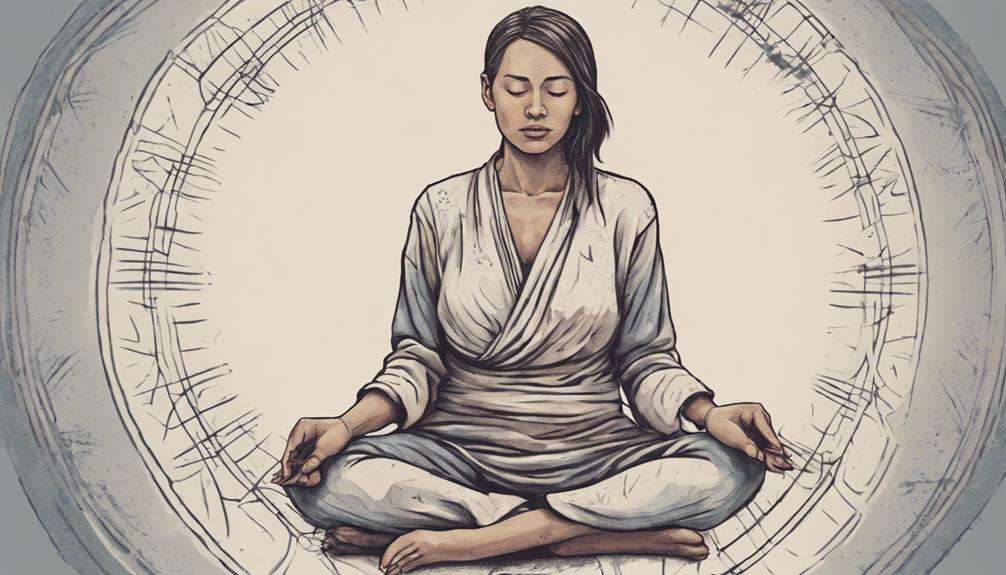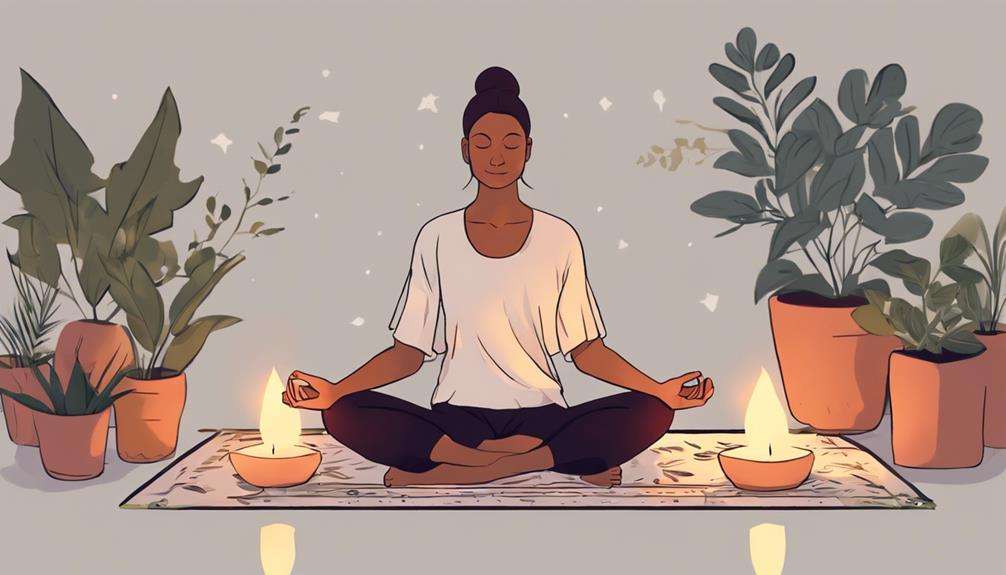You've likely heard of the power of meditation in fostering emotional well-being, but have you explored the top 10 techniques specifically tailored for emotional healing? These practices offer a diverse set of tools to navigate and address your emotions, from mindfulness and visualization to movement and mantra.
Each technique brings a unique approach to promote healing and resilience, guiding you towards a deeper understanding of yourself. Discover how these methods can transform your emotional landscape and support your journey towards inner peace and self-compassion.
Key Takeaways
- Guided visualization and healing imagery promote inner peace and emotional well-being.
- Mindful meditation enhances self-awareness and emotional resilience.
- Journaling aids in emotional processing and self-awareness.
- Mindful movement meditation fosters relaxation and mind-body connection.
Mindfulness Meditation
Embark on a journey of self-discovery and emotional healing through the transformative practice of Mindfulness Meditation. By centering your focus on the present moment, mindfulness meditation allows you to deepen your awareness of emotions and thought patterns. This heightened awareness can be a powerful tool in recognizing and understanding your feelings, leading to healthier coping mechanisms and increased emotional resilience.
Through mindfulness meditation, you cultivate a state of non-reactive observation towards your thoughts and emotions, enabling you to respond to situations with clarity and calmness. This practice not only helps in reducing stress but also fosters self-awareness and emotional healing. By acknowledging and accepting your emotions without judgment, you can begin to unravel emotional triggers and patterns that may have been hindering your well-being.
Incorporating mindfulness meditation into your daily routine can significantly enhance your mental health, promoting a sense of inner peace and emotional well-being. Take the time to nurture yourself through this practice, and watch as it transforms your relationship with your emotions and ultimately leads you towards greater emotional healing.
Guided Visualization
When you engage in guided visualization, you're invited to let go of stress and immerse yourself in healing imagery that calms the mind.
This practice offers a journey towards inner peace, guiding you to a tranquil mental space where emotional healing can unfold.
Calm the Mind
To cultivate a sense of inner peace and emotional balance, engage in guided visualization as a powerful tool for calming the mind and promoting healing.
Guided visualization offers a pathway to emotional healing by guiding you through calming visualizations that help in reducing stress and anxiety. By focusing on creating a peaceful mental space, this technique allows for a moment of relaxation, lowering stress levels, and enhancing your mood.
It provides a safe environment where overwhelmed emotions can find solace, leading to emotional balance. Practice guided visualization regularly to experience the benefits of a quieter mind and a more tranquil emotional state.
Embrace this method as a way to soothe your mind and nurture your emotional well-being.
Healing Imagery
Engage your imagination to create a tranquil mental sanctuary through Healing Imagery, a guided visualization technique that promotes emotional healing and stress relief.
By incorporating visualization and calming imagery, you can lower stress levels and enhance your emotional well-being. When you immerse yourself in this peaceful space of your own creation, you give your mind a chance to rest and rejuvenate, providing relief from emotional stress and anxiety.
Guided Visualization offers a powerful tool for understanding and processing your emotional triggers effectively. Take a moment to visualize a soothing scene or comforting place, allowing yourself to experience the healing effects of this practice.
Embrace the opportunity to nurture your emotional health through the transformative power of Healing Imagery.
Inner Peace Journey
Embark on a tranquil inner journey through Guided Visualization to discover and cultivate your inner peace. This meditation technique leverages imagination to create a safe mental space for emotional healing, aiding in relieving stress and anxiety by visualizing calming scenes.
By incorporating guided visualization into your routine, you can improve your mood and lower stress levels, providing a restful break for your emotions to heal. This practice enhances emotional healing by offering a tool to process and release negative emotions in a supportive environment.
Guided Visualization promotes relaxation, self-awareness, and emotional well-being, making it a valuable technique for those seeking to find inner peace and cultivate a sense of calmness within themselves.
Loving-Kindness (Metta) Meditation
Cultivate a sense of love and kindness within yourself and towards others through the practice of Loving-Kindness (Metta) Meditation. Engaging in this form of meditation can have a profound impact on your emotional well-being and relationships.
Here are some key benefits of Loving-Kindness Meditation:
- Increased Empathy Levels: By regularly practicing Loving-Kindness meditation, you can develop a deeper understanding and empathy towards others, fostering more meaningful connections.
- Positive Existence: This practice helps in shifting your focus towards positivity, allowing you to see the good in yourself and others, promoting a more optimistic outlook on life.
- Compassion: Through cultivating loving-kindness, you can nurture a compassionate heart, leading to kinder interactions and a more harmonious existence.
- Peaceful Existence: Embracing Loving-Kindness Meditation can bring about inner peace and tranquility, creating a serene environment both internally and externally.
- Forgiveness: This form of meditation encourages forgiveness, letting go of resentment and grudges, and promoting healing and reconciliation in your relationships.
Body Scan Meditation

As you begin to explore Body Scan Meditation, you'll discover the deep connection between your mind and body.
By focusing on different body parts, you can activate your body's relaxation response, easing tension and promoting a sense of calm.
This practice invites you to observe sensations without judgment, fostering a greater awareness of your physical and emotional well-being.
Mind-Body Connection
Enhance your mind-body connection through the practice of Body Scan Meditation, fostering a deeper awareness of your physical sensations and emotional well-being. By engaging in this mindfulness technique, you can cultivate a stronger bond between your body and mind, leading to various benefits such as:
- Increased self-awareness of bodily sensations
- Enhanced relaxation by releasing tension in different body parts
- Improved emotional resilience through better understanding of your body's responses
- Better quality of sleep as you learn to calm both your body and mind
- Strengthened mind-body connection for overall well-being and inner harmony.
Incorporating Body Scan Meditation into your routine can significantly contribute to your emotional healing journey, providing a holistic approach to wellness.
Relaxation Response
To initiate the relaxation response through Body Scan Meditation, begin by finding a comfortable and quiet space where you can focus on your breath and gradually shift your attention to different parts of your body.
Body scan meditation is a powerful relaxation technique that helps release physical tension, reduce stress levels, and enhance self-awareness. By tuning into the sensations in each body part without judgment, you can calm your mind and create a stronger mind-body connection.
Incorporating this practice into your routine can lead to better sleep and overall emotional healing. Take the time to prioritize this self-care technique, allowing yourself to unwind and nurture your well-being through the gentle exploration of your body and mind.
Breath Awareness Meditation
Immerse yourself in the present moment by focusing on the rhythm of your breath during Breath Awareness Meditation. This powerful technique allows you to observe your breath, reducing stress and bringing a sense of calm to your mind. As you practice Breath Awareness Meditation, you'll experience various benefits that can enhance your overall well-being:
- Improved Concentration: By honing in on your breath, you train your mind to stay focused, leading to better concentration in daily tasks.
- Emotional Regulation: This practice helps in managing emotions, allowing you to respond to situations with clarity and composure.
- Promotion of Relaxation: Focusing on your breath induces a state of relaxation, easing tension and promoting a sense of inner peace.
- Deep Connection: Through breath observation, you can connect deeply with yourself, fostering self-awareness and understanding.
- Enhanced Mindfulness: By paying attention to the nuances of your breath, you cultivate mindfulness, bringing awareness to the present moment and fostering a sense of clarity in your thoughts.
Journaling Post-Meditation

As you close your eyes after a meditation session, consider how journaling can amplify your emotional healing journey.
Writing down your reflections post-meditation can be a powerful tool for unraveling emotions and enhancing self-awareness.
Through this practice, you may uncover patterns, triggers, and growth that contribute to your emotional resilience.
Reflective Writing Benefits
Enhancing your emotional awareness and promoting self-reflection, journaling after meditation serves as a valuable tool for emotional healing and growth. After your meditation practice, taking the time to jot down your thoughts and feelings can lead to profound benefits.
- Enhanced Self-Awareness: Journaling post-meditation allows you to delve deeper into your emotions and experiences.
- Emotional Processing: It aids in the processing of complex emotions, helping you understand and manage them better.
- Therapeutic Tool: Serving as a therapeutic outlet, writing can be a cathartic experience for emotional release.
- Understanding Triggers: By journaling, you can identify emotional triggers and work towards emotional resilience.
- Daily Support: Incorporating reflective writing into your daily routine provides consistent emotional healing and well-being.
Emotional Processing Through Writing
After your meditation practice, journaling can be a powerful tool for processing and understanding your emotions on a deeper level. By engaging in written expression, you facilitate emotional processing and track your progress in emotional healing.
This therapeutic tool allows for self-expression and introspection, enabling you to delve into your feelings and thoughts post-meditation. Through journaling, you can identify patterns, triggers, and areas for personal growth, fostering a greater sense of self-awareness and emotional resilience.
Consistent journaling after meditation sessions can lead to profound insights and contribute to your overall emotional well-being. Embrace this practice as a means of nurturing your emotional health and promoting inner growth.
Mindful Movement Meditation
Experience the transformative power of mindful movement meditation as a gentle yet profound practice for fostering emotional healing. Mindful Movement Meditation combines mindfulness with physical activity to reduce stress and increase body awareness.
Here are some key points to consider:
- Practicing mindful movement enhances balance and promotes relaxation by focusing on the present moment.
- Engaging in mindful walking or movement helps integrate mindfulness into daily activities.
- Mindful movement meditation can be a gentle way to practice mindfulness for emotional healing.
- By paying attention to each movement and breath, mindful movement meditation fosters a deeper mind-body connection.
- Incorporating mindful movement into your routine can help you cultivate a sense of calm and presence in your daily life.
Take the time to explore mindful movement practices and witness the positive impact they can have on your emotional well-being.
Mantra Meditation

For those seeking a path to inner peace and mental well-being, mantra meditation offers a powerful and transformative practice. Mantra meditation involves the repetition of specific words or phrases, either silently or aloud, to focus the mind. This technique is particularly suited for transcendental meditation practices, helping to quiet fears and reach deeper meditative states. By chanting mantras, individuals can cope with mental hardships and achieve inner peace.
Simple mantras like 'OM' are effective in calming the mind and promoting emotional well-being. Through mantra meditation, positive beliefs are reinforced, mental well-being is enhanced, and self-awareness is increased. The act of chanting creates a rhythm that can soothe the mind and facilitate emotional healing.
Embrace mantra meditation as a tool to cultivate positivity, strengthen your mental resilience, and nurture a sense of tranquility within yourself.
Group Meditation Practices
By joining group meditation practices, you can tap into a powerful source of collective energy and support for your emotional healing journey. Engaging in group meditation offers a unique opportunity to connect with others on a deeper level and foster emotional well-being through shared energy and a sense of belonging. Here are some key benefits of participating in group meditation:
- Collective Energy: Sharing the meditative space with others amplifies the energy and intention, enhancing the overall experience.
- Supportive Environment: Group settings provide a safe space for exploring and processing emotions, knowing you aren't alone in your journey.
- Connection: Through group meditation, you can feel connected to others, creating a sense of community and understanding.
- Sense of Belonging: Being part of a meditation group cultivates a feeling of belonging and acceptance, which can be comforting during emotional healing.
- Shared Energy: The combined focus and energy of the group can deepen your practice and emotional healing journey.
Professional Meditation Guidance

When seeking professional meditation guidance for emotional healing, you gain access to structured practices and personalized support tailored to address specific challenges.
This type of professional guidance offers personalized techniques and creates a safe environment for emotional healing. Working with a meditation teacher provides a deeper understanding of meditation practices and their impact on emotional well-being. It helps individuals navigate through emotions, develop healthy coping mechanisms, and track progress in overcoming emotional barriers.
Frequently Asked Questions
How Do You Meditate for Emotional Healing?
To meditate for emotional healing, start with mindful breathing to calm your mind. Engage in visualization practice to release emotions. Cultivate self-compassion and loving-kindness. Explore body scan for relaxation. Try chakra balancing for emotional release and balance.
What Is the Powerful Meditation Technique?
You're looking for a powerful meditation technique? Try loving-kindness practice. It cultivates love and kindness, reduces negativity, and enhances relationships. By directing positive energy, this technique promotes happiness and emotional healing. Give it a try!
How Do You Meditate to Release Trauma?
To release trauma, start with grounding exercises and body scans. Visualize letting go of pain. Practice loving kindness, use mantras, and deep breaths. Try guided imagery. Embrace healing through these techniques for emotional release.
What Is the Highest Form of Meditation?
In your quest for the highest form of meditation, you'll embark on a journey of self-reflection, spiritual awakening, and inner peace. Through mindfulness and connection, you'll unlock healing energy, emotional release, and deep relaxation, experiencing enlightenment and transformation.
Conclusion
Incorporate these top 10 meditation techniques for emotional healing into your daily routine to cultivate inner peace and resilience.
Remember, 'The best time to plant a tree was 20 years ago. The second best time is now.' Take the first step towards emotional well-being by practicing mindfulness and self-compassion through these powerful meditation techniques.
You deserve to nurture your mind, body, and soul.
Start today and reap the benefits of healing and self-discovery.






